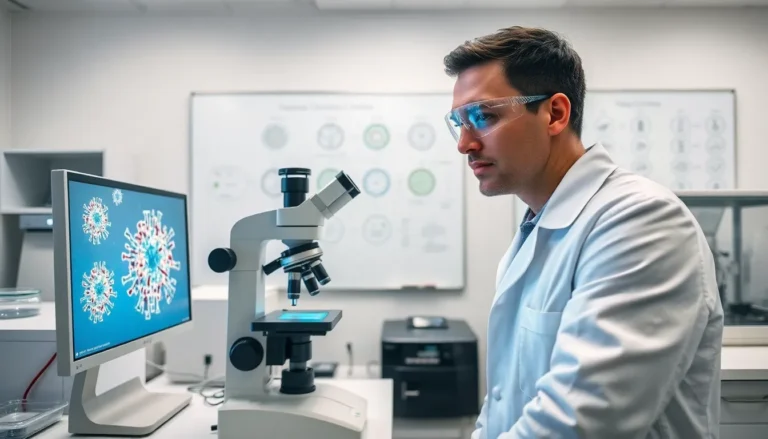Table of Contents
ToggleIn a world where collaboration often leads to magic, duet reactions take center stage, blending creativity and chemistry in the most delightful way. Imagine two elements coming together, each with its own quirks, to create something entirely new—like a dynamic duo of superheroes, but with a dash of science. Whether it’s in music or chemical reactions, the power of two can be astonishing.
Duet reactions showcase the beauty of synergy, proving that sometimes, two heads—or molecules—are better than one. They spark curiosity and ignite innovation, making them a hot topic in both scientific circles and casual conversations. So buckle up and get ready to explore the fascinating world of duet reactions, where the unexpected is just waiting to unfold.
Overview of Duet Reaction
Duet reactions represent collaborative interactions between two distinct elements in chemical or creative contexts. These interactions emphasize the power of synergy leading to innovative outcomes.
Definition of Duet Reaction
A duet reaction refers to the process where two elements or compounds engage interactively to produce a new result. This phenomenon occurs in various settings, influencing both chemical reactions and artistic collaborations. In chemistry, duet reactions often involve the formation of covalent bonds, showcasing how specific atoms can combine to create stable molecules. Such interactions are essential for understanding the complex nature of compounds and their behaviors when mixed.
Importance in Chemistry
Importance of duet reactions lies in their role in fundamental chemical processes. They drive the formation of diverse molecules crucial for life. These reactions facilitate processes like metabolism and energy production, underlining their critical nature in biological systems. The dynamic interplay between elements fosters novel compound creation, which impacts pharmaceuticals, materials science, and environmental chemistry. Researchers utilize insights from duet reactions to innovate and develop solutions addressing global challenges.
Mechanism of Duet Reaction
Duet reactions involve a series of structured steps that lead to the formation of new compounds.
Steps Involved
First, reactants approach each other, often requiring energy input to initiate the process. Next, their valence electrons interact, leading to the stabilization of covalent bonds. As these connections form, new molecular structures emerge, defining the characteristics of the resulting compounds. Finally, the reaction reaches completion, producing distinct outputs that exhibit unique properties.
Factors Influencing the Reaction
Many factors influence duet reactions. Temperature plays a crucial role, with increased heat typically accelerating the reaction rate. Additionally, the concentration of the reactants affects how readily they collide and interact. Pressure, especially in gaseous reactions, can also impact the speed and outcome of the process. Catalysts can introduce alternative pathways, allowing reactions to proceed with lower energy requirements.
Applications of Duet Reaction
Duet reactions find applications across various fields, showcasing their versatility and importance. From industry to research, these reactions play a pivotal role in advancing technology and knowledge.
Industrial Uses
Industries utilize duet reactions for synthesizing essential compounds. Chemical manufacturing often employs these reactions to create plastics, fuels, and pharmaceuticals. For instance, the production of polyethylene involves a duet reaction between ethylene molecules under specific conditions. Likewise, many polymers rely on these interactions to achieve desired properties, making them critical in the manufacturing of everyday products. Catalysts frequently enhance these industrial processes, improving efficiency and yield. Resins, coatings, and adhesives also benefit from duet reactions, as they create materials with unique performance characteristics. Overall, the industrial landscape thrives on the foundational components made possible by duet reactions.
Research and Development
In research and development, duet reactions stimulate innovation in chemistry and related sciences. Scientists explore the underlying mechanisms of these reactions, leading to discoveries of new materials and compounds. For example, advancements in drug design often stem from understanding how different elements interact. Researchers study these reactions to optimize catalytic processes for sustainable energy solutions. In materials science, insights from duet reactions guide the development of advanced nanomaterials. The exploration of intermolecular forces during these interactions yields profound knowledge relevant to various scientific fields. Progress in these areas underscores the crucial role of duet reactions in shaping future technologies.
Advantages and Limitations
Duet reactions present both benefits and challenges in their implementation and understanding. Recognizing these aspects is crucial for leveraging their potential effectively.
Benefits of Duet Reaction
Duet reactions foster creativity by enabling unique compound formation. Collaborations between distinct elements lead to innovative solutions in drug design and materials science. For instance, synthetic pathways that utilize duet reactions yield important pharmaceuticals with optimized properties. High efficiency often accompanies these processes, as the right conditions enhance product quality and quantity. Additionally, the versatility of duet reactions allows application across various industries, facilitating the development of sustainable technologies. Overall, the synergy achieved through duet reactions promotes advancement in fields like environmental chemistry and energy production.
Challenges in Application
Applying duet reactions can pose several challenges. Reaction conditions often require careful monitoring, as factors like temperature, concentration, and the presence of catalysts significantly influence outcomes. Understanding these parameters is crucial to achieving desired results. Safety considerations also emerge during experimentation, as some duet reactions may produce hazardous byproducts. Limited availability of suitable reagents or catalysts can hinder progress, particularly in specialized fields. While the pursuit of innovative compounds holds great potential, researchers must navigate these complexities to optimize reaction pathways effectively.
Future Directions in Duet Reaction Research
Emerging studies in duet reaction research focus on enhancing specificity and efficiency in chemical syntheses. The development of advanced catalysts promises to improve reaction rates while minimizing byproducts. Researchers emphasize the exploration of novel reaction conditions, aiming to uncover previously unobserved reaction pathways.
Investigating the interplay between reaction parameters, like temperature and pressure, can lead to breakthroughs in product yield. The application of machine learning techniques offers exciting possibilities for predicting outcomes of complex duet reactions. Enhanced computational models allow researchers to simulate reactions, providing insight into potential innovations.
Environmental considerations drive the shift toward greener duet reactions. Using sustainable reagents and optimizing reaction conditions contribute to reducing harmful waste. Biologically inspired approaches highlight the importance of incorporating natural processes, which can streamline synthesis and increase effectiveness.
Efforts to understand the mechanisms at play in duet reactions gain momentum. Detailed studies into electron transfer processes and bond formation take precedence in research agendas. These insights enable chemists to tailor reactions for specific applications, enhancing their utility in pharmaceuticals and materials science.
Interdisciplinary collaborations facilitate advancements in duet reactions. Chemists, material scientists, and biologists unite their expertise to solve complex challenges. This collaborative environment fosters innovation and creates opportunities for discovering unique compounds with substantial applications.
Future research in duet reactions also prioritizes practical applications. Focusing on real-world problems, such as energy production and waste remediation, ensures relevance in the broader scientific landscape. The ongoing exploration of duet reactions holds potential for significant breakthroughs, shaping sustainable practices in chemistry and beyond.
The exploration of duet reactions reveals a fascinating interplay between elements that drives innovation across multiple fields. By understanding the mechanisms and applications of these reactions, researchers can unlock new possibilities in chemistry and beyond. As advancements continue in catalysts and reaction conditions, the future looks bright for discovering sustainable and efficient solutions. The synergy found in duet reactions not only enhances creativity but also addresses pressing global challenges, showcasing the profound impact of collaboration in science.







